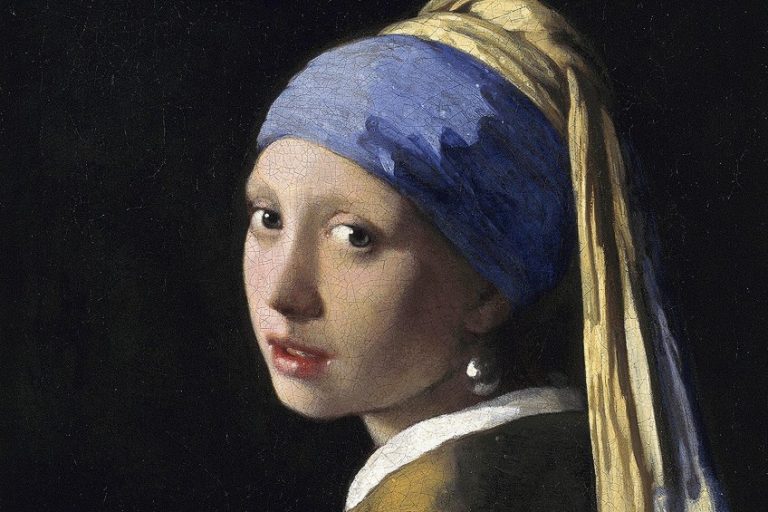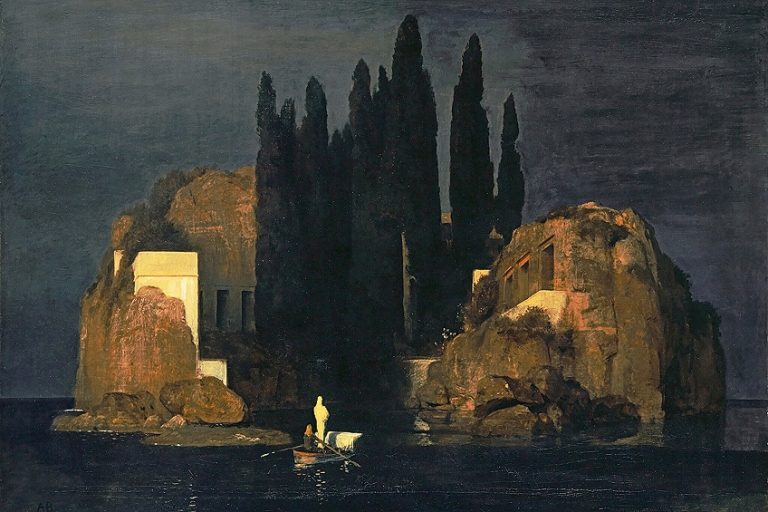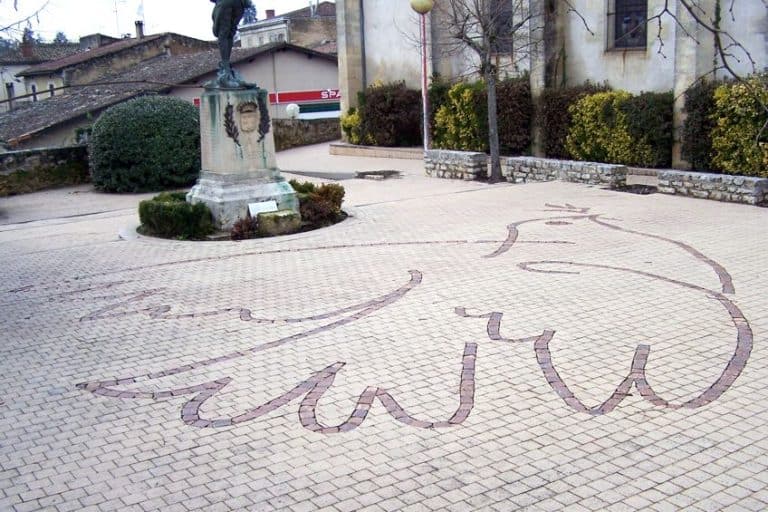“Reclining Nude” Amedeo Modigliani – Modigliani’s Reclining Woman
His name has been used for the medical condition called pseudo-goiter and he has been called Modi, which is the French term for “cursed”. Was this artist cursed? Did his name precede his art? Some would think so, especially the way he lived. This is, of course, Amedeo Modigliani, the painter who we will explore in more detail by looking at a reclining woman painting, just one example of many from this 20th-century artist.
Table of Contents
Artist Abstract: Who Was Amedeo Modigliani?
Amedeo Clemente Modigliani was born on 12 July 1884 in the city called Livorno in Tuscany, Italy. He was from a Sephardic Jewish family and had a good relationship with his mother, Eugénie Garsin, who would take him to visit the great paintings in Florence. She also helped him pursue his artistic studies with Guglielmo Micheli.
He moved to Paris in 1906 and was acquainted with many great artists like Pablo Picasso, Juan Gris, as well as Constantin Brancusi, who inspired him to start sculpting.
He was influenced by the artworks of Edvard Munch, Paul Cézanne, and Toulouse Lautrec. He had several exhibitions in Paris notably the Salon and Salon des Indépendants. Modigliani was sadly defeated from his alcohol and drug abuses, as well as his ill health from tuberculosis, and died when he was around 36 years old on 24 January 1920.
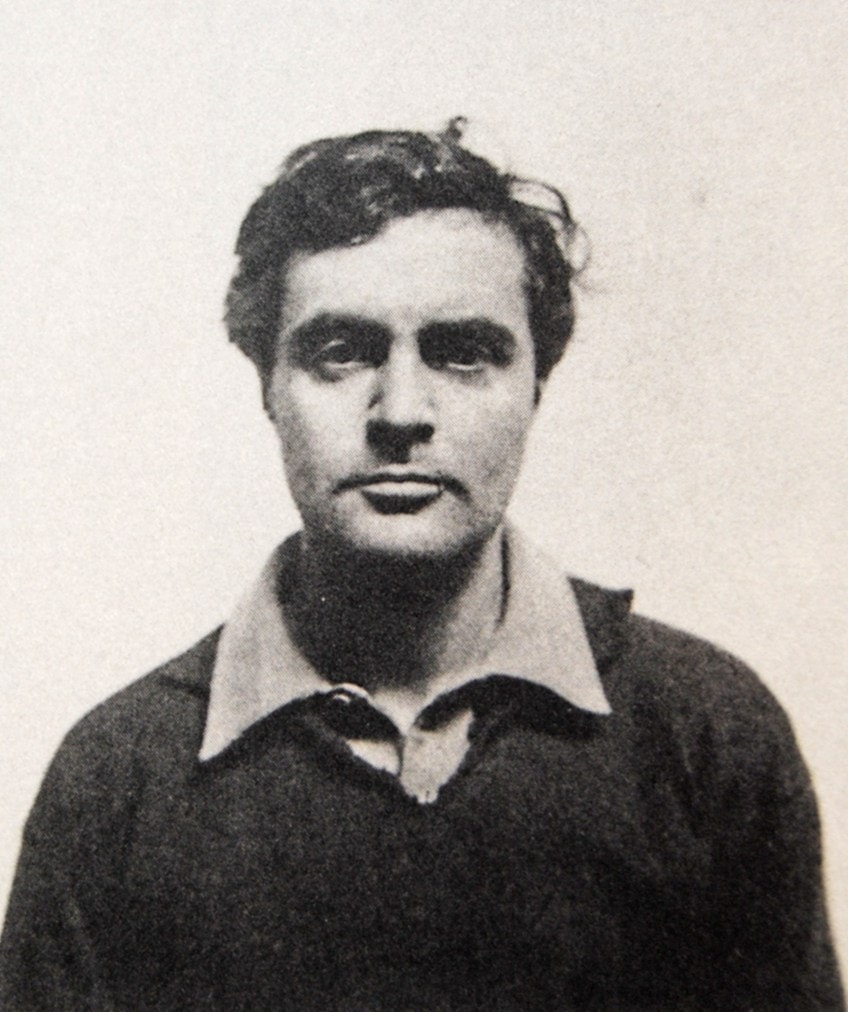
Reclining Nude by Amedeo Modigliani In Context
Amedeo Modigliani did not achieve artistic success when he was alive, he was a struggling artist in many ways. It was only after his death that his artistic career gained a level of success, sadly; his paintings have sold for millions of dollars. He was well-known for his figuration paintings and the primary subject matter was a reclining woman. He painted a series of reclining nudes from 1916 to 1919, which became one of his most famous series.
Below we will look at one of the Modigliani nudes in more detail titled, Nu Couché (Reclining Nude) (1917-1918), which is also known as Red Nude. We will provide a brief contextual analysis looking at why he painted the reclining women and other influences, as well as a formal analysis looking at his artistic style in terms of subject matter, color, brushwork, and more.

It is important to note that there were numerous iterations of the Modigliani nudes, and it is easy to be confused when we refer to one of them because they were all very similar in appearance. Therefore, as we look at Nu Couché (Reclining Nude), we will discuss it in more detail and mention other nudes from the series, noting the differences between them.
| Artist | Amedeo Clemente Modigliani |
| Date Painted | 1917-1918 |
| Medium | Oil on canvas |
| Genre | Nude painting |
| Period / Movement | Expressionism |
| Dimensions | 60 x 92 centimeters |
| Series / Versions | Part of his series of nude paintings |
| Where Is It Housed? | Private Collection of Liu Yiqian |
| What It Is Worth | $170,405,000 million (Christie’s in New York, 9 November 2015) |
Contextual Analysis: A Brief Socio-Historical Overview
Nu Couché (Reclining Nude) was painted from 1917 to 1918 in Paris. This was a time during the First World War and when Amedeo Modigliani was painting his series of reclining nude women. He was commissioned by his friend and art dealer Léopold Zborowski who he met in 1916.
Zborowski was a Polish art dealer and organized art exhibitions not only for Modigliani but other artists in Paris like the Fauvist André Derain.
Zborowski provided the artist with the materials he needed to paint, the models, as well as a space where he could paint. Furthermore, when Zborowski organized the exhibition for Modigliani, which was reportedly his first solo exhibition held at the Berthe Weill Gallery, the police shut it down because of its obscene content.

Zborowski reportedly placed some paintings in the gallery’s window. This perceived “obscenity” from the Modigliani nudes was believed to have given Modigliani more publicity. The police only shut down the opening day of the exhibition, which fortunately continued.
Modigliani’s reclining woman is not the only subject matter the artist explored – he also became known for his portrait paintings that appeared unique in their style. In fact, Modigliani was known for his unique portrayal of figurative painting. Before his reclining nudes, he painted an assortment of people.
He also drew inspiration from the prevailing art movement of the time called Fauvism, which means “wild beasts” in French. It is noted that from the year 1909, Modigliani also started his sculptures, where he was inspired and artistically influenced by Constantin Brancusi, who was a well-known sculptor from Romania.

Modigliani only pursued sculpture until around 1914 due to various reasons. However, during the time he sculpted he was significantly drawn to and influenced by other cultures, specifically African masks. We will notice that the stylization in Modigliani’s sculptures and portrait paintings of faces that appear like the styles from African tribal masks: the elongated faces and eyes that are almond-shaped.
Formal Analysis: A Brief Compositional Overview
Below we will look at Nu Couché (Reclining Nude) (1917-1918) in more detail. Modigliani was known for his unique and “stylized” paintings; he painted his figures with elongated necks and faces, the latter was often also quite angular with seemingly squinted eyes described as “almond” in shape. Furthermore, his portraits have been described as depicting the personalities of those painted.
Due to Modigliani’s “signature” style of elongated necks and faces, his name has been used to describe a medical condition called pseudo-goiter, which has been termed the “Modigliani syndrome”, where there is an exaggeration of the curve in the neck.
It was Modigliani’s reclining woman painting collection that stole – and stopped – the show though, as these figures appeared controversial in their nudity and emblematic of beauty and the ideas of desire and life.

Modigliani’s nudes made a statement of a different type of woman in the 20th century – it showed a woman who was confident and not afraid to be seen. Considering how women were portrayed throughout history, here Modigliani portrayed women as not meek or coy goddesses from mythology, perfectly delineated in academically based contours and colors, but an everyday woman.
Furthermore, we will also see in Modigliani’s style that he drew on other influences from other cultures and traditions, including those of African masks and the Cubist style of angular figures and faces. His inclusion of these influences clearly shows his veer towards the artistic styles of Primitivism, and maybe we can also surmise that Modigliani was influenced by the figurative paintings from the Renaissance era, of which paintings he viewed when he was a young boy, he merely made it his own.
Let us take a closer look below.
Subject Matter
In this 1917 to 1918 reclining nude, Amedeo Modigliani depicts a woman lying on what is either a couch or bed covered in a red covering or blanket with small golden scribbles suggesting patterns on it. She lies on a light blue pillow, which is under her head and to below her mid-back. Next to the blue pillow, there appears to be another dark green pillow or cushion.
This reclining woman lies with her arms opened and reaching to above her head. Her left arm (our right) appears tucked behind her head and her right hand (our left) is cut off by the wrist; both her wrists and hands are not visible to us, the viewers.
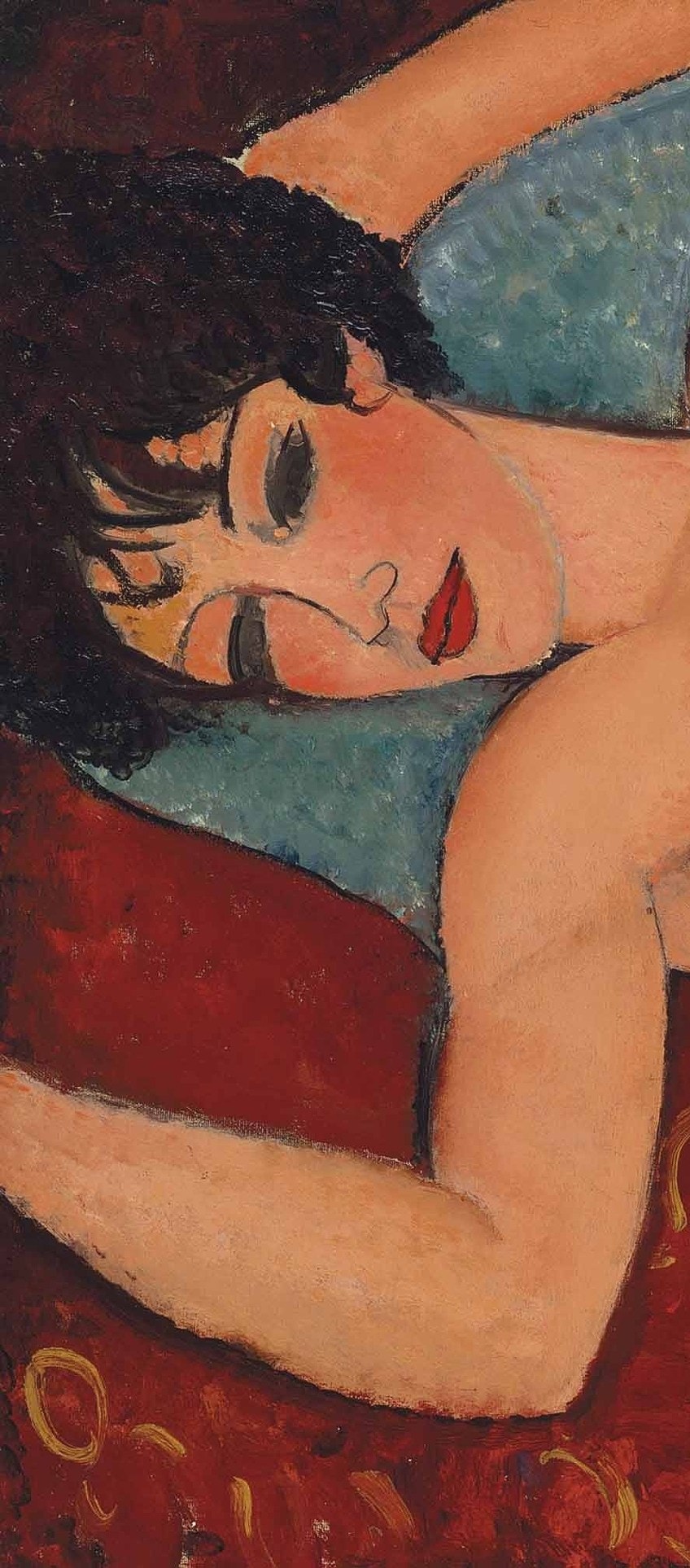
A detail of Nu couché (Reclining Nude) (1917) by Amedeo Modigliani; Amedeo Modigliani, Public domain, via Wikimedia Commons
Similarly, we can only see her upper thighs, the rest of her legs and feet on the bed or couch are not visible to us. Most of the composition is filled with the figure of the reclining woman. Her body creates a strong almost curved horizontal line from one end of the canvas to the other.
Her golden nude skin tone is difficult to miss with the darker background colors of reds and greens highlighting her nudity. If we look at her body shape, Modigliani depicted a toned female figure, which appears like an hourglass shape.
She has dark brown hair, which appears to be short in this painting, although it could possibly be long and simply tucked behind her head so that we cannot view it. She has red lips with dark outlines around them and her eyes seem to be closed, suggesting she could be asleep, which further highlights her relaxed pose.
Her eyelids are painted in a darker charcoal color, which could suggest she is wearing make-up. She has thin stylized eyebrows.
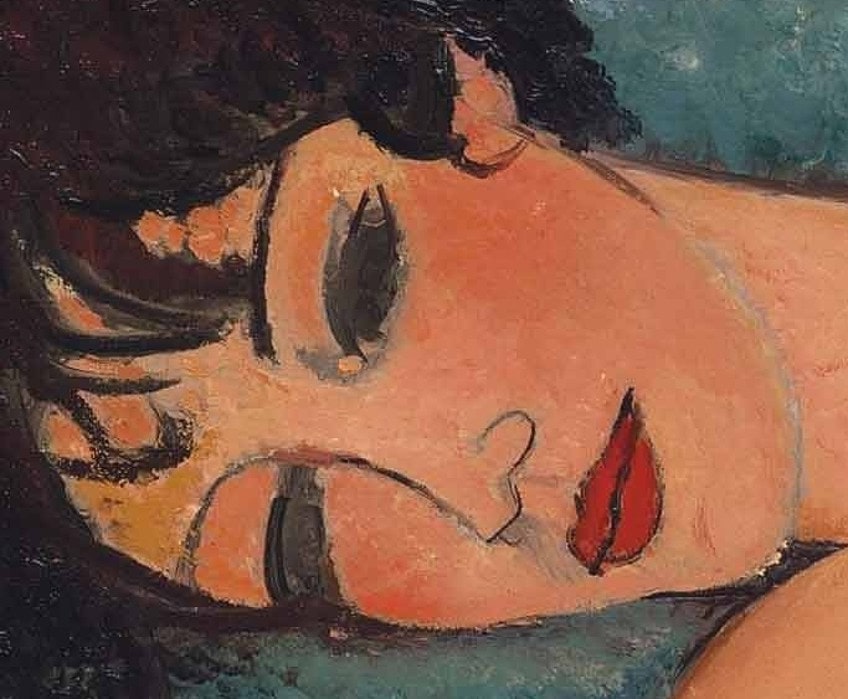
We also notice that Modigliani portrayed his reclining woman with her body hair, we notice hair suggested under her armpits as well as her pubic area. In most of Modigliani’s nudes, we see this depicted, which gives them an unabashed and realistic appearance. Furthermore, her facial expression appears calm and tranquil, all adding to her beauty and sexual seductiveness, which undoubtedly has made this painting an attraction in the art world.
This is also a testament to how Modigliani portrayed the female nude in all her glory compared to the more traditional – and accepted – nudes from the Renaissance period.
We see this similar pose in Modigliani’s other reclining woman painting called Reclining Nude (1917), which is housed in the Metropolitan Museum of Art in New York City, United States. Here she lies similar with her body creating a curved horizontal line dominating the composition, however, we see more of her side. Her eyes appear to be open here, gazing at us. Her arms are similarly held behind her back and head, again we cannot see her hands.

What is different about Reclining Nude (1917) is her smaller mouth, which is pursed with hints of her white teeth. Her nose and face are more elongated and angular than Nu Couché (Reclining Nude) (1917-1918), who we could argue appears fuller and more voluptuous in her appearance and therefore more sexually attractive?
Color and Brushwork
Amedeo Modigliani painted in rich reds, greens, and mustards, often with lighter shades of blue here and there. He depicted the nudes with lightly tanned skin tones while some appeared with fairer skin tones. When we view the Modigliani reclining woman painting, we immediately see that the dominating color is that of the primary subject of the painting, which is the reclining woman.
Modigliani’s brushwork in Nu Couché (Reclining Nude) (1917-1918) appears seemingly haphazardly applied, especially around the reclining woman. If we look closer, we can see the individual brushstrokes applied with ease and freedom, not too preoccupied with a more traditional or academic style of applying paint.
Furthermore, Modigliani utilized dark outlines around the female’s figure, but also notably around the blue cushion she lies on.
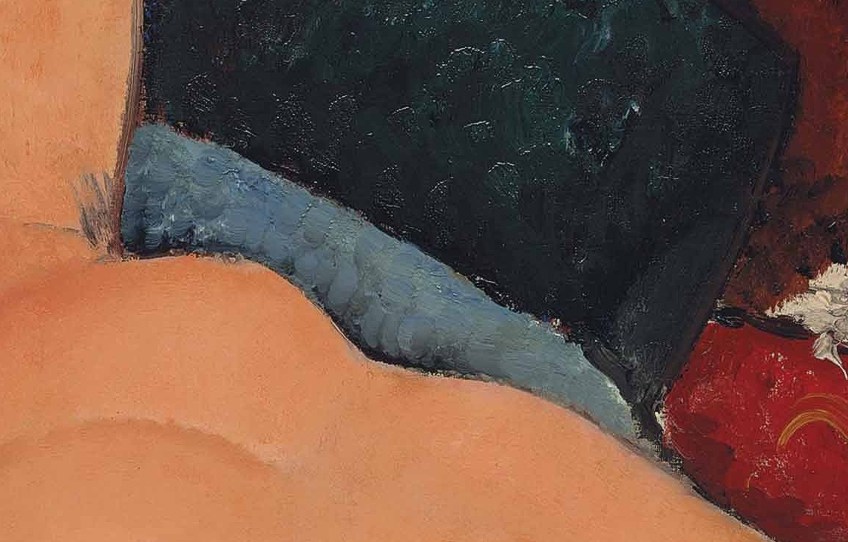
This expressive use of and application of paint can point to the influences from art styles that emerged during the time Modigliani painted, especially that of Expressionism and Fauvism. These art styles were characterized by their fluid brushstrokes and vivid colors to express the artists’ inner emotional worlds.
Perspective
Modigliani portrays his nudes from different angles, but we will often see the reclining woman from an aerial viewpoint as if the artist painted from a heightened view. In Nu Couché (Reclining Nude) (1917-1918) we see her mostly from above, however not too far above, just enough to get a glimpse of most of her body.
Other examples of Modigliani nudes appear from the frontal views where some are seated, such as in Iris Tree (c. 1916), which is housed at the Courtauld Institute of Art in London, England, and Seated Nude (1917), housed at the Royal Museum of Fine Arts Antwerp in Belgium.
Others are depicted reclining more on their sides for example Nude (1917), which is housed at the Solomon R. Guggenheim Museum in New York City, United States, while others rest on their elbows, for example, Nude on a Blue Cushion (1917), which is housed in the National Gallery of Art in Washington D.C., United States.

“I am Modigliani, the Jew”
This is apparently how he sometimes introduced himself. Although he was a Jew he has often been described as a “bohemian”. He did not lead an easy life, most of the time Modigliani struggled to earn enough money from his artworks and he suffered from his addictions and health problems. Nonetheless, he was remembered as always appearing quite dashingly dressed – even Pablo Picasso was remembered to have made compliments about how the Jewish artist dressed.
He was further remembered through his biography, written by his daughter Jeanne Modigliani titled Modigliani: Man and Myth (1958). Several films were made in his honor, namely, Les Amants de Montparnasse (1958) and Modigliani (2004). There are also nine novels written about him, he became the subject of a play and several musical compositions.
Modigliani drew inspiration from different art movements of the time, he was surrounded by a developing new world in art and culture, from Cubism, Fauvism, even Surrealism, and others. He amalgamated what he perceived into his own “brand” so to say. Some people place him within Expressionism, but maybe he could never be placed anywhere – a “bohemian” at heart and a Jew by blood, he created his own look in so many ways.
Frequently Asked Questions
What Is the Famous Reclining Woman Painting?
There are over 20 reclining nude paintings by the Italian Jewish painter, Amedeo Modigliani. He painted these nudes as part of a series, commissioned by the art dealer Léopold Zborowski from 1916 to 1919. Some of the Modigliani nudes are Nu Couché (Reclining Nude) (1917-1918), which is part of a private collection, and Reclining Nude (1917) in the Metropolitan Museum of Art. Modigliani’s reclining woman series of paintings are all housed in different art galleries and art museums around the world.
What Are the Modigliani Nudes Worth?
Amedeo Modigliani’s series of paintings of reclining nude women have sold for millions of dollars only after the artist’s death in 1920. His Nu Couché (Reclining Nude) (1917-1918) was sold for $170,405,000 million in 2015 at the Christies. It was bought by Liu Yiqian and became part of a private collection. This painting has been one of the most paid-for paintings.
What Are the Characteristics of Amedeo Modigliani’s Paintings?
Amedeo Modigliani developed a personal artistic style of painting subject matter. He was known for painting figures with elongated necks, long faces that often appeared angular with eyes that were “almond-shaped”. The faces he painted often appeared mask-like, which points to his influence from African masks. He was also influenced by the sculptor Constantin Brancusi.
What Type of Art Did Amedeo Modigliani Make?
Amedeo Modigliani was well-known for his portrait and nude paintings. He painted with oils on canvas. He also took up sculpture for a few years, inspired by the sculptor Constantin Brancusi. He utilized limestone for his sculptures. He also produced numerous drawings and sketches.
Who Did Modigliani Paint?
Although Amedeo Modigliani was famous for painting his reclining female nudes, he also painted many other people, including writers and artists, and other significant figures within the creative world. Some include Pablo Picasso, the art dealer Paul Guillaume, Léon Indenbaum, Moise Kisling, Beatrice Hastings, who was Emily Alice Haigh, a writer and literary critic from England, Blaise Cendrars, Juan Gris, his patron Léopold Zborowski, and others. He also painted everyday people like women, youth, Jeanne Hébuterne, who was known as his common-law wife, and last, but not least, himself.
Alicia du Plessis is a multidisciplinary writer. She completed her Bachelor of Arts degree, majoring in Art History and Classical Civilization, as well as two Honors, namely, in Art History and Education and Development, at the University of KwaZulu-Natal, South Africa. For her main Honors project in Art History, she explored perceptions of the San Bushmen’s identity and the concept of the “Other”. She has also looked at the use of photography in art and how it has been used to portray people’s lives.
Alicia’s other areas of interest in Art History include the process of writing about Art History and how to analyze paintings. Some of her favorite art movements include Impressionism and German Expressionism. She is yet to complete her Masters in Art History (she would like to do this abroad in Europe) having given it some time to first develop more professional experience with the interest to one day lecture it too.
Alicia has been working for artincontext.com since 2021 as an author and art history expert. She has specialized in painting analysis and is covering most of our painting analysis.
Learn more about Alicia du Plessis and the Art in Context Team.
Cite this Article
Alicia, du Plessis, ““Reclining Nude” Amedeo Modigliani – Modigliani’s Reclining Woman.” Art in Context. November 10, 2021. URL: https://artincontext.org/reclining-nude-amedeo-modigliani/
du Plessis, A. (2021, 10 November). “Reclining Nude” Amedeo Modigliani – Modigliani’s Reclining Woman. Art in Context. https://artincontext.org/reclining-nude-amedeo-modigliani/
du Plessis, Alicia. ““Reclining Nude” Amedeo Modigliani – Modigliani’s Reclining Woman.” Art in Context, November 10, 2021. https://artincontext.org/reclining-nude-amedeo-modigliani/.




